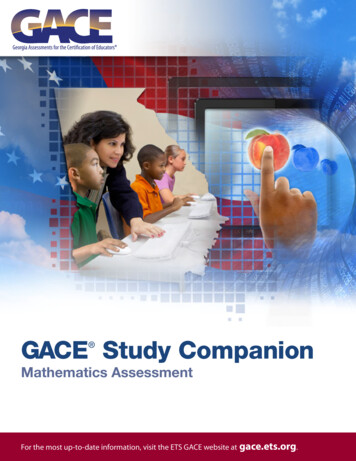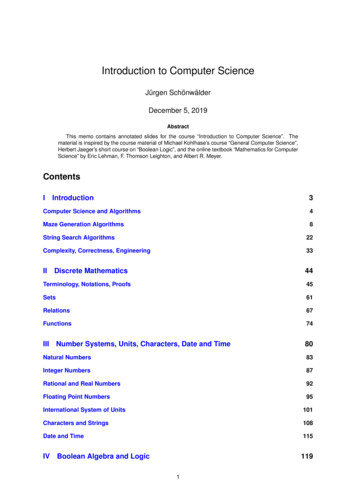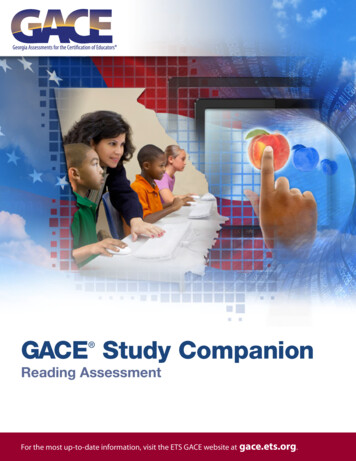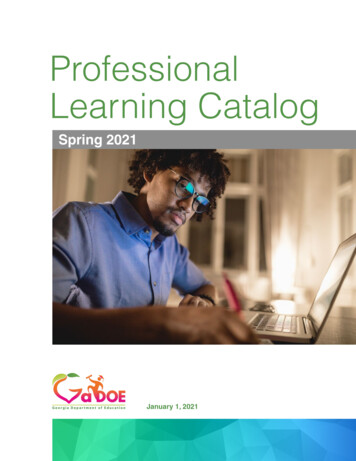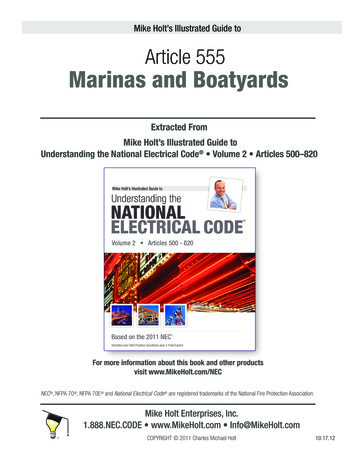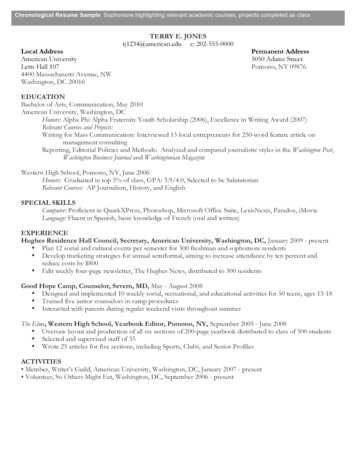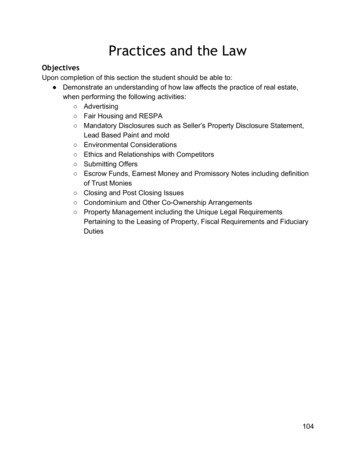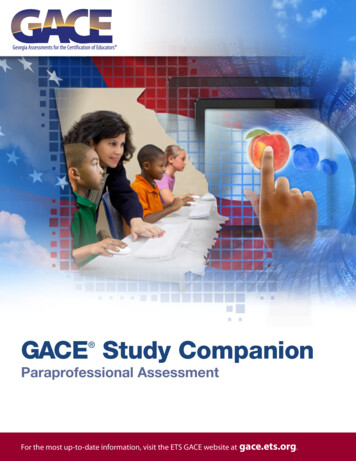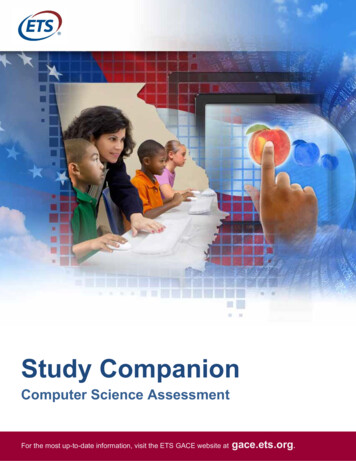
Transcription
Study CompanionComputer Science AssessmentFor the most up-to-date information, visit the ETS GACE website atgace.ets.org.
Last Updated: June 2018Copyright 2018 by Educational Testing Service. All rights reserved. ETS is a registeredtrademark of Educational Testing Service (ETS). Georgia Assessments for the Certification ofEducators, GACE, and the GACE logo are registered trademarks of the Georgia ProfessionalStandards Commission (GaPSC). All other trademarks are property of their respective owners.This publication has been produced for the GaPSC by ETS. ETS is under contract to theGaPSC to administer the Georgia Assessments for the Certification of Educators. TheGeorgia Assessments for the Certification of Educators are administered under the authorityof the GaPSC; regulations and standards governing the program are subject to change withoutnotice at the discretion of the GaPSC. The GaPSC and ETS are committed to preventingdiscrimination on the basis of race, color, national origin, sex, religion, age, or disability in theadministration of the testing program or the provision of related services.
Table of ContentsAbout the Assessment . 4Content Specifications . 5Test Subareas . 6Test Objectives. 6Subarea I: Impacts of Computing . 6Subarea II: Algorithms and Computational Thinking . 7Subarea III: Programming . 9Subarea IV: Data .13Subarea V: Computing Systems and Networks .15Code Segments.17Pseudocode Notation .17Practice Questions .19Answer Key and Rationales .37Preparation Resources .44Guide to Taking a GACE Computer-delivered Assessment .44Reducing Test Anxiety.44Study Tips: Preparing for a GACE Assessment .44Journals.44State-adopted Instructional Materials .44Other Resources .45Online Resources .45Note: After clicking on a link, right click and select “Previous View” to go back to original text.GACE Computer Science Assessment Study Companion3
About the AssessmentAssessment NameComputer ScienceGrade LevelP–12Test Code555Testing Time3 hoursTest Duration3.5 hoursTest FormatComputer deliveredNumber of Selected-response Questions100Question FormatThe test consists of a variety of short-answerquestions such as selected-responsequestions, where you select one answerchoice or multiple answer choices (dependingon what the question asks for), questionswhere you enter your answer in a text box,and other types of questions. You can reviewthe possible question types in the Guide toTaking a GACE Computer-delivered Test.Number of Constructed-response Questions0The GACE Computer Science assessment is designed to measure the professional knowledgeof prospective teachers of computer science in the state of Georgia.The testing time is the amount of time you will have to answer the questions on the test. Testduration includes time for tutorials and directional screens that may be included in the test.The total number of questions that are scored is typically smaller than the total number ofquestions on the test. Most tests that contain selected-response questions also includeembedded pretest questions, which are not used in calculating your score. By including pretestquestions in the assessment, ETS is able to analyze actual test-taker performance on proposednew questions and determine whether they should be included in future versions of the test.Note: After clicking on a link, right click and select “Previous View” to go back to original text.GACE Computer Science Assessment Study Companion4
Content SpecificationsThis assessment is organized into content subareas. Each subarea is further defined by a setof objectives and their knowledge statements. The objectives broadly define what an entry-level educator in this field in Georgia publicschools should know and be able to do. The knowledge statements describe in greater detail the knowledge and skills eligible fortesting. Some tests also include content material at the evidence level. This content serves asdescriptors of what each knowledge statement encompasses.See a breakdown of the subareas and objectives for this assessment on the following pages.Note: After clicking on a link, right click and select “Previous View” to go back to original text.GACE Computer Science Assessment Study Companion5
Test SubareasApprox. Percentageof TestSubareaI. Impacts of Computing15%II. Algorithms and Computational Thinking25%III. Programming30%IV. Data15%V. Computing Systems and Networks15%Test ObjectivesSubarea I: Impacts of ComputingObjective 1: Understands and applies knowledge of impact of, obstacles to, and effectsof computingThe beginning Computer Science teacher:A. Understands computing as a way of expressing creativity, solving problems, enablingcommunication, and fostering innovation in a variety of fields and careers Recognizes that computers can be used to showcase creativity Recognizes the benefits of using computers to solve problems Provides examples of how computers enable communication and collaboration Provides examples of how computers foster innovationB. Knows the obstacles to equal access to computing among different groups and theimpact of those obstacles Identifies obstacles to equal access to computing among different groups (e.g.,groups defined by gender, socioeconomic status, disability/accessibility needs) andthe impact of those obstacles Identifies factors that contribute to the digital divide Matches obstacles to equal access with effective solutionsC. Understands beneficial and harmful effects of computing innovations and the trade-offsbetween them Analyzes computing innovations in terms of their social, economic, and culturalimpacts, both beneficial and harmful Identifies trade-offs between beneficial and harmful effects of computer innovationsNote: After clicking on a link, right click and select “Previous View” to go back to original text.GACE Computer Science Assessment Study Companion6
Objective 2: Understands and applies knowledge of issues regarding intellectual property,ethics, privacy, and security in computingThe beginning Computer Science teacher:A. Knows different methods of protecting intellectual property rights and the trade-offsbetween them in a variety of contexts (e.g., Creative Commons, open source, copyright) Using correct vocabulary, describes how different methods of protecting intellectualproperty rights work Given a context, identifies appropriate methods of protecting intellectual propertyrights Identifies and compares trade-offs between different methods of protectingintellectual property rightsB. Understands ethical and unethical computing practices and their social, economic, andcultural implications Identifies ethical and unethical computing practices in context Describes the social, economic, and cultural implications of ethical and unethicalcomputing practices Identifies the conditions under which a given computing practice is ethical or legalC. Knows privacy and security issues regarding the acquisition, use, and disclosure ofinformation in a digital world Using correct vocabulary, describes privacy and security issues In context, identifies appropriate strategies to safeguard privacy and ensure security Describes trade-offs between local and cloud-based data storage Identifies methods that digital services use to collect information about usersSubarea II: Algorithms and Computational ThinkingObjective 1: Understands and applies knowledge of abstraction, pattern recognition, problemdecomposition, number base conversion, and algorithm formatsThe beginning Computer Science teacher:A. Understands abstraction as a foundation of computer science Identifies, creates, or completes the correct ordering, from low to high, of anabstraction hierarchy Identifies abstractions in context Identifies details that can be removed from a solution in order to generalize itB. Knows how to use pattern recognition, problem decomposition, and abstraction todevelop an algorithm Given a table of values or other data source, identifies the patterns in the data andidentifies algorithms that could produce the patternsNote: After clicking on a link, right click and select “Previous View” to go back to original text.GACE Computer Science Assessment Study Companion7
Identifies components that could be part of an algorithm to solve a problem Identifies actions and actors when decomposing a problem Identifies appropriate decomposition strategiesC. Understands number base conversion and binary, decimal, and hexadecimal numbersystems Converts between number bases Analyzes and compares representations of numbers in different basesD. Understands how to develop and analyze algorithms expressed in multiple formats(e.g., natural language, flowcharts, pseudocode) Interprets diagrams that describe algorithms, given an explanation of the symbolsused Compares algorithms written in multiple formats Traces and analyzes algorithms written in different formats Identifies correct sequencing of steps in an algorithm and errors in sequencingObjective 2: Understands and applies knowledge of algorithm analysis, searching and sortingalgorithms, recursive algorithms, and randomizationThe beginning Computer Science teacher:A. Is familiar with the limitations of computing in terms of time, space, and solvability as wellas with the use of heuristic solutions that can address these limitations Identifies and compares algorithms that are linear, quadratic, exponential, orlogarithmic Recognizes the existence of problems that cannot be solved by a computer In context, identifies factors that prevent a problem from being solvable Identifies situations where heuristic solutions are useful In context, identifies space and time limitations of computational solutionsto problemsB. Understands searching and sorting algorithms; can analyze sorting algorithms forcorrectness and can analyze searching algorithms for correctness and efficiency Traces algorithms and predicts output and intermediate results Calculates the number of comparisons required for linear and binary searchalgorithmsC. Understands simple recursive algorithms (e.g., n factorial, sum of first n integers) Traces simple recursive algorithms Provides missing steps in incomplete simple recursive algorithms Identifies parts of a recursive algorithm (e.g., base or stopping condition,recursive call)Note: After clicking on a link, right click and select “Previous View” to go back to original text.GACE Computer Science Assessment Study Companion8
Identifies errors in simple recursive algorithms Identifies an iterative algorithm that is equivalent to a recursive algorithmD. Is familiar with the use of randomization in computing Identifies appropriate uses of randomization in a variety of applications Identifies the difference between random and pseudorandom numbersSubarea III: ProgrammingObjective 1: Understands and applies knowledge of programming control structures, standardoperators, variables, correctness, extensibility, modifiability, and reusabilityThe beginning Computer Science teacher:A. Understands how to write and modify computer programs in a text-based programminglanguage Describes what a program does or is able to choose the code segment that correctlyimplements a given intended purpose Identifies missing code in a code segment with a stated intended purpose Places statements in appropriate order to create a correct program Identifies how changing one part of a code segment will affect the outputB. Understands how to analyze computer programs in terms of correctness Traces code and indicates the output printed or the value of variables after codesegment execution Indicates the inputs that produce given outputs for a code segment Describes what a program does or chooses the code segment that correctlyimplements a given intended purpose Identifies valid preconditions and postconditions Compares two code segments or algorithms Identifies the type of error produced by a code segment (i.e., syntax, runtime,compile-time, overflow, round-off, logic) Identifies errors in incorrect code and changes that can be made to correct themC. Knows the concepts of extensibility, modifiability, and reusability Identifies the meaning of the terms Identifies functionally equivalent statements or code segments that differ in one ofthese three ways Identifies situations where the use of constants or variables would be preferred overhard-coded values Identifies opportunities for parameterizationNote: After clicking on a link, right click and select “Previous View” to go back to original text.GACE Computer Science Assessment Study Companion9
Chooses code that improves on given code by making it more extensible, modifiable,or reusable Identifies changes that would improve a given code segmentD. Understands the three basic constructs used in programming: sequence, selection, anditeration Traces code and indicates the output printed or the value of variables after codesegment execution Indicates inputs that produce given outputs for a code segment Describes what a program does or chooses the code segment that correctlyimplements a given intended purpose Identifies missing code in a code segment with a stated intended purpose Identifies equivalent statements or code segments Identifies the three constructs when used in code Identifies which of the constructs are needed to implement given functionality Converts code that does not use iteration to equivalent code that uses iterationE. Understands how to use standard operators (i.e., assignment, arithmetic, relational,logical) and operator precedence to write programs Traces code and indicates the output displayed or the value of variables after codesegment execution Indicates inputs that produce given outputs for a code segment Describes what a program does or chooses the code segment that correctlyimplements a stated intended purpose Identifies missing code in a code segment with a stated intended purpose Identifies equivalent statements or code segments Places statements in appropriate order to create a correct program Uses Boolean algebra to identify equivalent Boolean expressions Writes a Boolean expression equivalent to a given code, or identifies code equivalentto a given Boolean expression or English description Identifies the correct implementation of a given formula, including formulas withfractions Evaluates expressions that include arithmetic operationsF. Understands how to use variables and a variety of data types Identifies variables and data types (e.g., integers, floating point, string, Booleans,arrays/lists) Identifies the need for type conversion Traces code and indicates the output printed or the value of variables after codesegment executionNote: After clicking on a link, right click and select “Previous View” to go back to original text.GACE Computer Science Assessment Study Companion10
Indicates the inputs that produce given outputs for a code segment Describes what a program does or chooses the code segment that correctlyimplements a stated intended purpose Identifies missing code in a code segment with a stated intended purpose Identifies equivalent statements or code segments Places statements in appropriate order to creates a correct program Describes the difference between integer and floating point numeric data types Describes the difference between integer and floating point division Describes the benefits of the use of each data type Distinguishes between global and local scope Identifies the most appropriate data type in a given context Identifies the correct sequence of string operations to produce a given outputObjective 2: Understands and applies knowledge of procedures, event-driven programs,usability, data structures, debugging, documenting and reviewing code, libraries and APIs,IDEs, and programming language paradigms, including object-oriented conceptsThe beginning Computer Science teacher:A. Understands how to write and call procedures with parameters and return values Traces code and indicates the output printed or the value of variables after codesegment execution Indicates inputs that produce given outputs for a code segment Describes what a program does or chooses the code segment that correctlyimplements a stated intended purpose Identifies missing code in a code segment with a stated intended purpose Identifies equivalent statements or code segments Places statements in appropriate order to create a correct program Traces code when references to objects and arrays are passed to procedures Traces code that includes nested procedure callsB. Knows the concepts of event-driven programs that respond to external events(e.g., sensors, messages, clicks) Traces code and indicates the output printed or the value of variables after codesegment execution Indicates inputs that produce given outputs for a code segment Describes what a program does or chooses the code segment that correctlyimplements a stated intended purpose Identifies missing code in a code segment with a stated intended purposeNote: After clicking on a link, right click and select “Previous View” to go back to original text.GACE Computer Science Assessment Study Companion11
Identifies possible errors due to asynchronous events Identifies aspects of concurrency in event-driven programmingC. Is familiar with usability and user experience (e.g., ease of use and accessibility) Identifies code that improves on given code in terms of usability or user experience Identifies meaningful error messages Identifies features that improve accessibilityD. Is familiar with dictionaries/maps, stacks, and queues Identifies a data structure based on a description of behavior or appropriate use Given goals, constraints, or context, identifies the most appropriate data structure Traces code that uses a particular data structureE. Understands how to use debugging techniques and appropriate test cases Identifies which test cases are most useful for given code Differentiates between different types of errors (e.g., overflow, round-off, syntax,runtime, compile-time, logic) Describes useful debugging techniques (e.g., where to put print statements) Differentiates between empirical testing and proof Identifies errors in code and solutions to those errorsF. Is familiar with characteristics of well-documented computer programs that are usable,readable, and modular Identifies characteristics of good documentation Identifies good and poor documentation practices in contextG. Is familiar with techniques to obtain and use feedback to produce high-quality code(e.g., code reviews, peer feedback, end user feedback) Identifies situations in which each of the three listed techniques are usefulH. Knows how to use libraries and APIsI. Identifies correct call(s) and use of return values given an API definition Identifies reasons to use or not use libraries in place of writing original code Identifies applications (e.g., math libraries, random number generation) that use APIsUnderstands programming techniques to validate correct input and detect incorrect input Identifies effective input data validation strategies Compares data validation (proper range and format) and data verification(e.g., password verification) Identifies improvements to code for which data validation is requiredNote: After clicking on a link, right click and select “Previous View” to go back to original text.GACE Computer Science Assessment Study Companion12
J. Is familiar with the features and capabilities of integrated development environments(IDEs) Identifies components of IDEs Identifies benefits and drawbacks of using IDEs Identifies the costs and benefits of context editorsK. Is familiar with the differences between low- and high-level programming languages Identifies characteristics of low- and high-level languagesL. Is familiar with different programming paradigms Identifies the terminology of procedural programming Identifies the terminology of object-oriented programming Compares programming paradigmsM. Knows object-oriented programming concepts Identifies classes, instance variables, and methods given a diagram Identifies the benefits of inheritance and encapsulation Identifies distinctions between overloading and overridingN. Is familiar with program compilation and program interpretation Identifies differences between compilation and interpretation Identifies differences between source code and object codeSubarea IV: DataObjective 1: Understands and applies knowledge of digitalization, data encryption anddecryption, and computational toolsThe beginning Computer Science teacher:A. Understands bits as the universal medium for expressing digital information Performs calculations, using bits and bytes Determines the number of bits and bytes required to store a given amount of data Given the description of an encoding scheme, encodes or decodes data Describes lossy and lossless data compression Explains why binary numbers are fundamental to the operation of computer systemsB. Is familiar with concepts of data encryption and decryption Distinguishes between encoding and encryption Identifies trade-offs in the use of data encryptionNote: After clicking on a link, right click and select “Previous View” to go back to original text.GACE Computer Science Assessment Study Companion13
C. Knows how to use computational tools, including spreadsheets, to analyze data in orderto discover, explain, and visualize patterns, connections, and trends Transforms data to make it more useful Identifies specific data or characteristics of specific data that need to be removed ormodified before an entire data set can be used Describes the use of spreadsheet operations (e.g., formulas, filters, sorts, charts,graphs) to analyze and visualize dataObjective 2: Understands and applies knowledge of simulation, modeling, and manipulationof dataThe beginning Computer Science teacher:A. Is familiar with the use of computing in simulation and modeling Describes questions that can be answered with a given simulation, or explains whatdata and process are required in a simulation in order to answer a given question Traces code in a simulation context Identifies missing code in a simulation context Identifies the impact of changes to simulations (e.g., more or fewer variables, moreor less data) Identifies applications of simulation and modelingB. Is familiar with methods to store, manage, and manipulate data Uses terminology and concepts of files and databases Identifies measures of file size (e.g., byte, kilo, mega, giga, tera, peta) Identifies issues connected with the storage requirements of computing applications,including scale, redundancy, and backupC. Is familiar with a variety of computational methods for data collection, aggregation, andgeneration Identifies the benefits of working with publicly available data sets Identifies the types of data generated by surveys and sensors Identifies examples of crowdsourcing and citizen science Identifies appropriate data-collection methods for a given context and purposeNote: After clicking on a link, right click and select “Previous View” to go back to original text.GACE Computer Science Assessment Study Companion14
Subarea V: Computing Systems and NetworksObjective 1: Understands and applies knowledge of operating systems, computing systems,communication between devices, and cloud computingThe beginning Computer Science teacher:A. Knows that operating systems are programs that control and coordinate interactionsbetween hardware and software components Identifies hardware components and their functions Identifies software components and their functions Identifies common operating systems tasks Identifies resource issues that have an impact on functionalityB. Is familiar with computing systems embedded in everyday objects (e.g., Internet ofThings [IoT], ATMs, medical devices) Describes what an embedded system is Defines what the IoT is and how it is used Describes how sensors are used in embedded systemsC. Knows the capabilities, features, and uses of different types of computing systems(e.g., desktop, mobile, cluster) Identifies capabilities, features, and uses for each type of computer system Identifies criteria to evaluate and compare computing systemsD. Is familiar with computers as layers of abstraction from hardware (e.g., logic gates,chips) to software (e.g., system software, applications) Identifes appropriate abstraction layers for hardware and software componentsE. Is familiar with the steps required to execute a computer program (fetch-decode-executecycles) Describes what happens during fetch, decode, and execute, including the order ofthe steps in the cycleF. Is familiar with trade-offs between local, network, and cloud computing and storage Identifies advantages and disadvantages in terms of performance, cost, security,reliability, and collaboration Identifies means of storing binary dataG. Is familiar with communication between devices Identifies and compares wireless communication systems Identifies and compares wired communication systems Identifies and compares network typesNote: After clicking on a link, right click and select “Previous View” to go back to original text.GACE Computer Science Assessment Study Companion15
Objective 2: Understands and applies knowledge of networks, including security issues andthe WebThe beginning Computer Science teacher:A. Knows components of networks Identifies network hardware devices and their functions Describes possible abstraction models of networksB. Is familiar with factors that have an impact on network functionality Defines basic terminology (e.g., bandwidth, load, latency) Estimates necessary bandwidth and data size for a given situation Identifies critical resources for a given situationC. Is familiar with how Internet and Web protocols work Describes the purpose of protocols and identifies common Internet andWeb protocols Compares IPv4 and IPv6 Identifies and describes the basic parts of a URL (e.g., protocol, subdomain, domainname, port, path) Describes the hierarchical structure of names in the domain name system (DNS) Describes the purpose and function of IP addressing Identifies how Internet protocols address reliability, redundancy, and error handlingD. Is familiar with digital and physical strategies for maintaining security Identifies characteristics of strong passwords (e.g., length, bits per character) Identifies digital and physical security strategies Identifies trade-offs in the use of security measures (e.g., encryption, decryption,digital signatures and certificates)E. Is familiar with concepts of cybersecurity Identifies and defines the five pillars of cybersecurity: confidentiality, integrity,availability, nonrepudiation, and authenticationF. Is familiar with the components that make up the Web (e.g., HTTP, HTML, browsers,servers, clients) Identifies the uses of markup languages Identifies the purposes of browsers, servers, and clientsNote: After clicking on a link, right click and select “Previous View” to go back to original text.GACE Computer Science Assessment Study Companion16
Code SegmentsSome stimulus material contains code segments written in pseudocode. The notation used inthe pseudocode is described belowPseudocode NotationExplanationNotationAssignment operator Arithmetic operators - / * %Note that / indicates floating point divisionunless stated otherwise.Relational operators Logical operatorsandornotString concatenation operator Boolean valuestruefalseNullnullComments// this is a single-line commentPlaceholder for missing codeFor example,/* missing code *//* missing condition */print argPrintA comment is used where necessary toindicate if a line feed or blank is appended tothe argument.Data ingArray initialization and referenceint[] a{1, 2, 3}int b[0.2]{1, 2, 3}int[][] c a[0]Note: After clicking
The GACE Computer Science assessment is designed to measure the professional knowledge of prospective teachers of computer science in the state of Georgia. The testing time is the amount o

